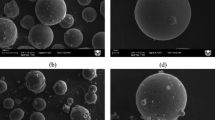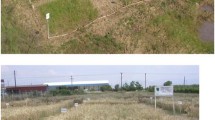Abstract
Adding coal ash to acid waste decreases its acidity and supplies essential nutrients to plants. The effects of coal ash on acid coal mine waste and acid mine drainage were investigated in the field. Treatments were mixtures of coal mine waste with coal ash (0, 20, and 40%). Addition of coal ash increased the pH of coal mine waste and leachate by 3.11 and 3.03 units, respectively. After stabilization, the concentrations in the leachate decreased from 4.65 to 0.44 mg L−1 for Fe and from 0.31 mg L−1 to “not detected” for Pb. The organic matter content and cation exchange capacity increased significantly (approximately twofold each), for coal mine waste with coal ash. Moreover, plant growth on coal mine waste that had been treated with coal ash was greatly stimulated. The application of coal ash offers an environmentally compatible, cost-effective way to remediate coal mine waste or leachate contaminated with heavy metals.





Similar content being viewed by others
References
Lee JY, Han MY, Yang JS, Choi JY (2009) A study on environmental. Mine geographic information system approach for the sustainable mine management and prevention of mine hazards. J Environ Policy 8:130–143
Oh SJ, Kim SC, Ko JI, Lee JS, Yang JE (2011) Evaluating stabilization efficiency of coal combustion ash (CCA) for coal mine wastes: column experiment. Korean J Soil Sci Fertil 44:1071–1079
Yang JE, Skousen JG, Ok YS, Yoo KY, Kim HJ (2006) Reclamation of abandoned coal mine waste in Korea using lime cake by-products. Mine Water Environ 25:227–232
Woo BM (2000) Evaluation for rehabilitation countermeasures of coal-mined spoils and denuded lands. J Korean Environ Restor Technol 3:24–34
Jeon SR, Shin IJ, Lee KS (2001) Geochemistry of stream water around the abandoned Boeun coal mine, Hoenam Area. Korean J Environ Agric 20:20–27
Ok YS, Usman ARA, Lee SS, Abd El-Azeem SAM, Choi BS, Hashimoto Y, Yang JE (2011) Effects of rapeseed residue on lead and cadmium availability and uptake by rice plants in heavy metal contaminated paddy soil. Chemosphere 85:677–682
Lee GS, Song YJ (2010) Characterization of leaching of heavy metal and formation of acid mine drainage from coal mine tailings. J Korean Inst Resour Recycl 19:54–62
Yang JE, Kim HJ, Ok YS, Lee JY, Park JH (2007) Treatment of abandoned coal mine discharged waters using lime wastes. Geosci J 11:111–114
Ahmad M, Hashimoto Y, Moon DH, Lee SS, Ok YS (2012) Immobilization of lead in a Korean military shooting range soil using eggshell waste: an integrated approach. J Hazard Mater 209–210:392–401
Min KW, Chin HI, Yang JE (2004) Heat treatment of waste limes for their utilization in some abandoned mines. J Korean Soc Soil Groundw Environ 41:90–95
Yang JE, Lee WY, Ok YS, Skousen J (2009) Soil nutrient bioavailability and nutrient content of pine trees (Pinus thunbergii) in areas impacted by acid deposition in Korea. Environ Monit Assess 157:43–50
ME (2011) The Korean standard method of environmental pollutions for water pollution. Ministry of Environment, Seoul (in Korean)
NIAST (2000) Methods of soil chemical analysis. National Institute of Agricultural Science and Technology, RDA, Suwon (in Korean)
RDA (2000) Analyses of soil and plant. National Institute of Agricultural Science and Technology (in Korean)
Yoo KY, Cheong YW, Ok YS, Yang JE (2005) Neutralization of pyrophyllite mine wastes by the lime cake by-product. Korean J Environ Agric 24:215–221
Ahn NK, Oh JI, Lee JH (2007) AMD neutralization by alkali-producing reactor packed with fine recycled-concrete aggregates. J Korea Soc Waste Manag 24:185–192
Oh SJ, Kim SC, Kim TH, Yeon KH, Lee JS, Yang JE (2011) Determining kinetic parameters and stabilization efficiency of heavy metals with various chemical amendment. Korean J Soil Sci Fertil 44:1063–1070
Oh SJ, Kim SC, Yoon HS, Kim HN, Kim TH, Yeon KH, Lee JS, Hong SJ, Yang Jae E (2011) Evaluating heavy metal stabilization efficiency of chemical amendment in agricultural field. Field experiment. Korean J Soil Sci Fertil 44:1052–1062
Min JG, Park EH, Moon HS, Kim JK (2005) Chemical properties and heavy metal content of forest soils around abandoned coal mine lands in the Mungyeong area. Korean J Agric For Meteorol 7:265–273
Stewart BR, Daniels WL, Zelazny LW, Jackson ML (2001) Evaluation of leachate from coal refuse blended with fly ash at different rates. J Environ Qual 30:1382–1391
Adriano DC, Page AL, Elseewi AA, Chang AC, Straughan I (1980) Utilization and disposal of fly ash and other coal residues in terrestrial ecosystems. J Environ Qual 9:333–344
Haering CK, Daniels WL (1991) Fly ash: characteristics and use in mined land reclamation. Va Coal Energy J 3:33–46
Ziemkiewicz PF, Skousen J (2000) Use of coal combustion products for reclamation. Greenlands 30:36–47
Bulusu S, Aydilek AH, Rustagi N (2007) CCB-based encapsulation of pyrite for remediation of acid mine drainage. J Hazard Mater 143:609–619
Yeheyis MB, Shang JQ, Yanful EK (2009) Long-term evaluation of coal fly ash and mine tailings co-placement: a site-specific study. J Environ Manag 91:237–244
Saarsalmi A, Mälkönen E, Kukkola M (2004) Effect of wood ash fertilization on soil chemical properties and stand nutrient status and growth of some coniferous stands in Finland. Scand J For Res 19:217–233
Kang DH, Kwon BH, Yu HS, Kim SO (2010) Discharge characteristics of heavy metals in acid mine drainage from the abandoned Ilgwang mine. Korea Soc Eng Geol 20:79–87
ME (2002) The Korean standard method of environmental pollutions for soil pollution. Ministry of Environment, Seoul (in Korean)
James V, Bothe JR, Paul WB (1999) Arsenic immobilization by calcium arsenate formation. Environ Sci Technol 33:3806–3811
Tony SS, Pant KK (2006) Solidification stabilization of arsenic containing solid wastes using Portland cement, fly ash and polymeric materials. J Hazard Mater 131:29–36
Pickering WF (1982) Extraction of copper, lead, zinc or cadmium ions sorbed on calcium carbonate. J Water Air Soil Pollut 20:299–309
Yeheyis MB, Shang JQ, Yanful EK (2008) Characterization and environmental evaluation of Atikokan coal fly ash for environmental applications. J Environ Eng Sci 7:481–498
Rios CA, Williams CD, Roberts CL (2008) Removal of heavy metals from acid mine drainage (AMD) using coal fly ash, natural clinker and synthetic zeolites. J Hazard Mater 156:23–35
Gupta AK, Dwivedi S, Sinha S, Tripathi RD, Rai UN, Singh SN (2007) Metal accumulation and growth performance of Phaseolus vulgaris grown in fly ash amended soil. Bioresour Technol 98:3404–3407
Matsi T, Keramidas VZ (1999) Fly ash application on two acid soils and its effect on soil salinity, pH, B, P and on ryegrass growth and composition. Environ Pollut 104:107–112
Rai UN, Pandey K, Shinha S, Singh A, Saxena R, Gupta DK (2004) Revegetating fly ash landfills with Prosopis Juliflora L.: impact of different amendments and Rhizobium inoculation. Environ Int 30:293–300
Acknowledgments
This study was supported by 2014 research Grants from Kangwon National University (No. C1010720-01-01) and the Energy and Resource Recycling of the Korea Institute of Energy Technology Evaluation and Planning (KETEP) Grant funded by the Korean Government Ministry of Knowledge Economy (No. 2010T100100611).
Author information
Authors and Affiliations
Corresponding author
Rights and permissions
About this article
Cite this article
Kim, S.C., Oh, S.J., Oh, S.M. et al. In situ reclamation of closed coal mine waste in Korea using coal ash. Appl Biol Chem 60, 265–272 (2017). https://doi.org/10.1007/s13765-017-0275-y
Received:
Accepted:
Published:
Issue Date:
DOI: https://doi.org/10.1007/s13765-017-0275-y




